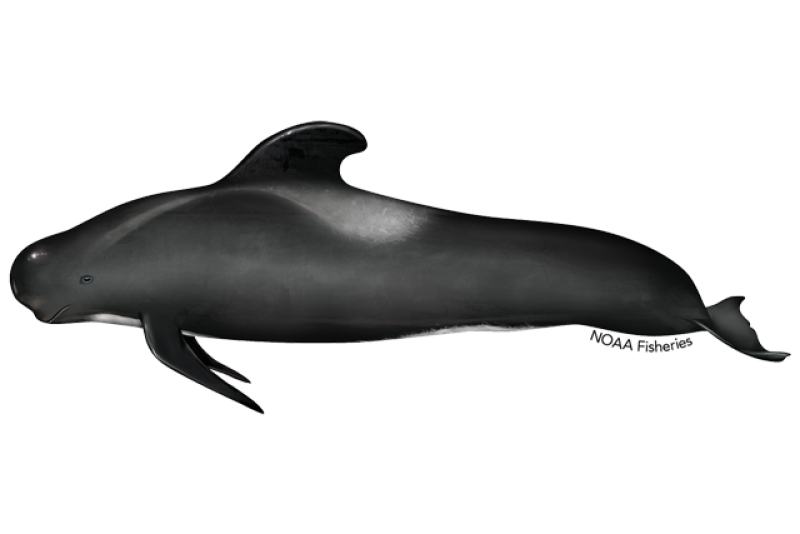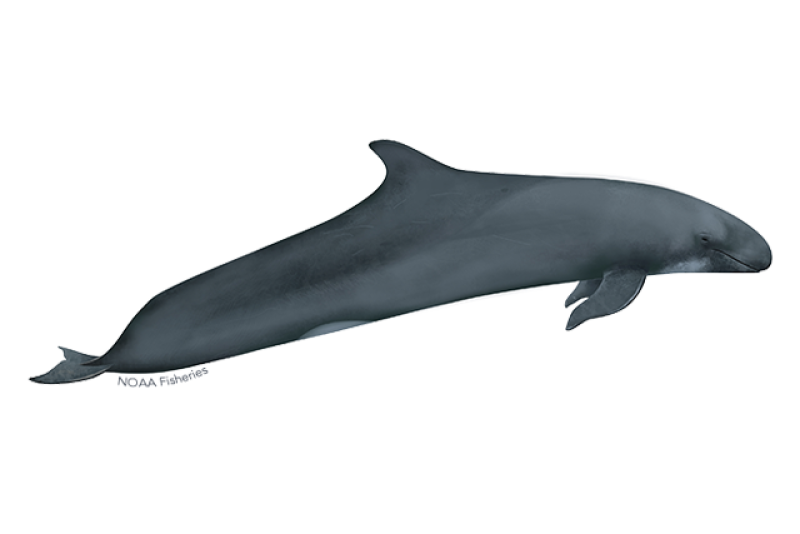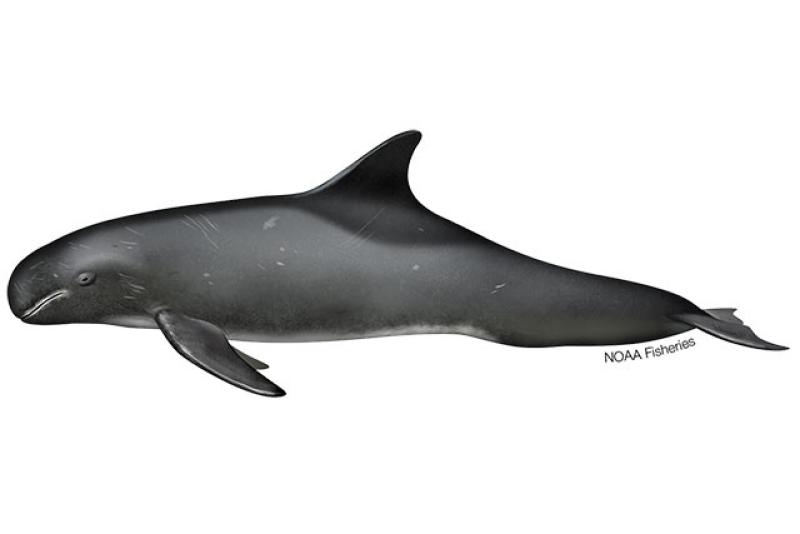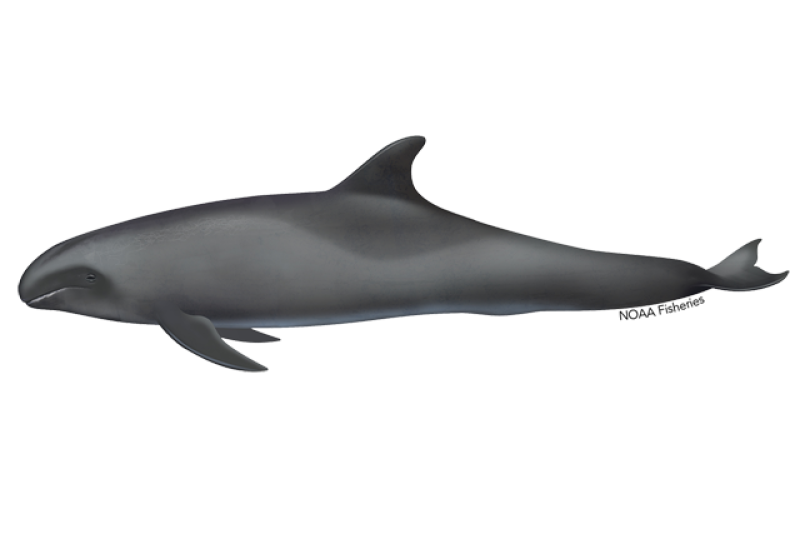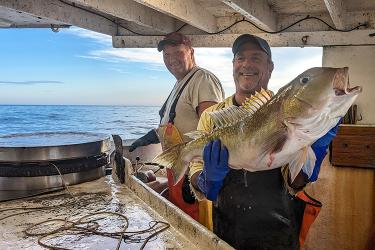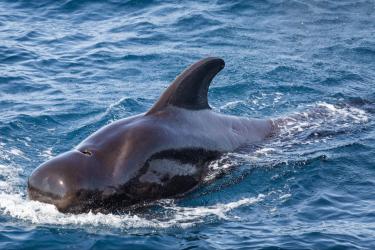Short-Finned Pilot Whale
Globicephala macrorhynchus
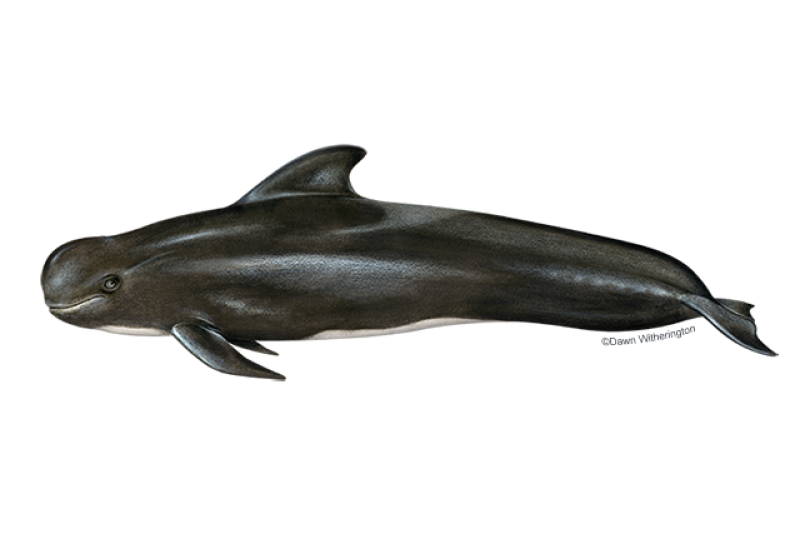
Protected Status
Quick Facts
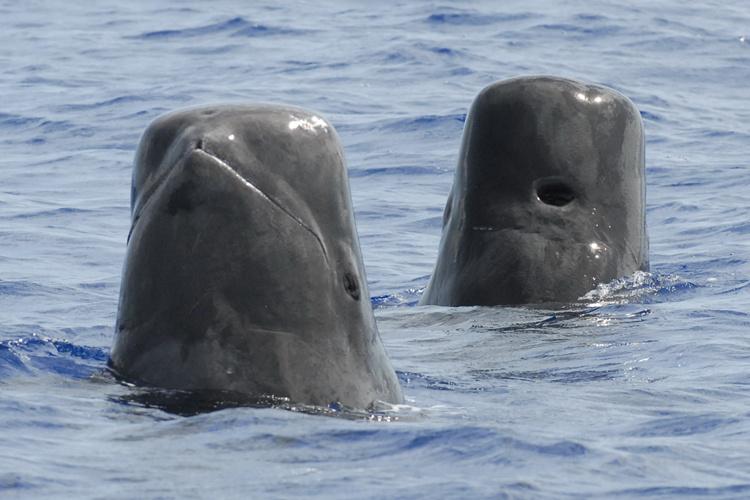 Short-finned pilot whales spy-hopping in the waters off of Guam. Credit: NOAA Fisheries
Short-finned pilot whales spy-hopping in the waters off of Guam. Credit: NOAA Fisheries
Short-finned pilot whales spy-hopping in the waters off of Guam. Credit: NOAA Fisheries
About the Species
 Short-finned pilot whales spy-hopping in the waters off of Guam. Credit: NOAA Fisheries
Short-finned pilot whales spy-hopping in the waters off of Guam. Credit: NOAA Fisheries
Short-finned pilot whales spy-hopping in the waters off of Guam. Credit: NOAA Fisheries
Short-finned pilot whales are found globally in tropical and temperate oceans. They are one of two species of pilot whale, along with the long-finned pilot whale. The two species differ slightly in size, features, coloration, and pattern. In the field and at sea, it is very difficult to tell the difference between the two species.
Short-finned pilot whales are long-lived, slow to reproduce, and highly social. They live in stable groups of 15 to 30 animals composed of close family relatives, and tend to live in localized, resident populations, although some populations have wider ranges. Their diet consists primarily of squid, with a small amount of fish. They are commonly found along the coast close to the continental shelf, although some populations have been found to extend into deep, open ocean environments such as in the eastern tropical Pacific Ocean. Pilot whales are often involved in mass strandings for reasons that are still unclear.
Three stocks of short-finned pilot whales are recognized in U.S. waters, which live along the U.S. east and west coasts, and around the Hawaiian Islands. On the west coast, short-finned pilot whales were once commonly seen, with an apparently resident population around Santa Catalina Island. After a strong El Niño in 1982 and 1983, short-finned pilot whales virtually disappeared from this area, and there are now thought to be about 800 animals in the West Coast stock. About 23,500 animals comprise the East Coast stock, around 2,000 in the Gulf of America* (formerly Gulf of Mexico) stock, and about 9,000 animals in the Hawaiian stock.
Population Status
Short-finned pilot whales, like all marine mammals, are protected under the Marine Mammal Protection Act.
Appearance
The short-finned pilot whale has a bulbous melon head with no obvious rostrum. Its dorsal fin is far forward on its body and has a relatively long base. The body is black or dark brown, with a large gray saddle behind the dorsal fin.
Behavior and Diet
Short-finned pilot whales feed mainly on squid, but they may also feed on octopus and fish, all from moderately deep water of 1,000 feet or more. When they are traveling and foraging, a pilot whale group can spread out over an area a half-mile wide.
Short-finned pilot whales often occur in groups of 25 to 50 animals. Males have more than one mate—typically a group has one mature male for every eight mature females. Males generally leave their birth school, while females may stay in theirs for their entire lives.
They are known as the “cheetahs of the deep sea” for their deep, high-speed dives to chase and capture large squid.
Where They Live
Short-finned pilot whales prefer warmer tropical and temperate waters. They can be found at varying distances from shore but typically prefer deeper waters. Areas with a high density of squid are their main foraging habitats.
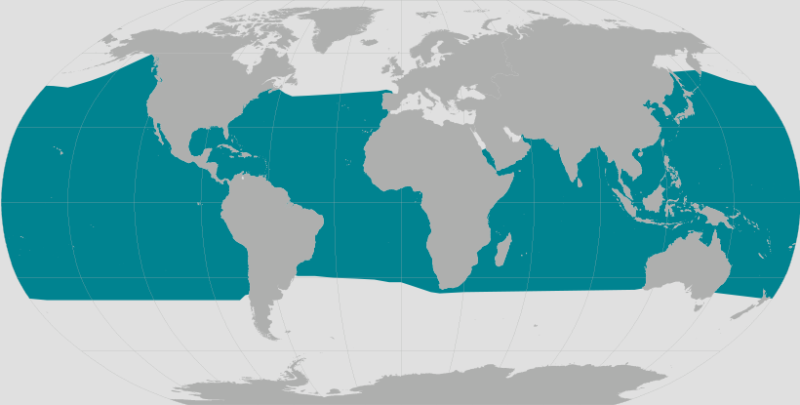 World map providing approximate representation of the short-finned pilot whale's range.
World map providing approximate representation of the short-finned pilot whale's range.
Lifespan & Reproduction
Short-finned pilot whales mature at around 10 years of age. The maximum lifespan is 45 years for males and 60 years for females.
Females have calves every 5 to 8 years. Older females do not give birth as often as younger females. They are pregnant for about 15 months, then nurse for at least 2 years. The last calf born to a mother may be nursed for as long as 15 years.
Threats
Entanglement in Fishing Gear
Short-finned pilot whales can become entangled in fishing gear, either swimming off with the gear attached or becoming anchored. They can become entangled in many different gear types, including gillnets, longlines, and trawls. Once entangled or hooked, whales may drag and swim with attached gear for long distances, resulting in fatigue, compromised feeding ability, or severe injury, which may lead to reduced reproductive success and death.
Hunting
Short-finned pilot whales are directly targeted and hunted in Japan and the Lesser Antilles.
Vessel Strikes
Vessel strikes can injure or kill short-finned pilot whales. Scarred short-finned pilot whales have been observed in Hawaiian waters.
*Executive Order 14172, “Restoring Names That Honor American Greatness” (Jan. 20, 2025), directs that the Gulf of Mexico be renamed the Gulf of America. Gulf of America references in this website refer to the same area as the Gulf of Mexico in the applicable regulations under 50 CFR parts 216–219, 222–226, and 600–699. The name change did not result in any changes to, and had no effect on the applicability or enforceability of, any existing regulations. This website continues to use “Gulf of Mexico” when quoting statutes, existing regulations, or previously published materials.
Scientific Classification
| Kingdom | Animalia | Phylum | Chordata | Class | Mammalia | Order | Cetacea | Family | Delphinidae | Genus | Globicephala | Species | macrorhynchus |
|---|
Last updated by NOAA Fisheries on 04/24/2025
What We Do
Conservation & Management
We are committed to protecting short-finned pilot whales. Our work includes:
- Reducing interactions with fishing gear
- Reducing vessel strikes
- Minimizing the effects of noise disturbance
- Responding to stranded pilot whales
- Educating the public about pilot whales and the threats they face
Science
Our research projects have discovered new aspects of pilot whale biology, behavior, and ecology and helped us better understand the challenges that all pilot whales face. This research is especially important in maintaining populations. Our work includes:
- Undertaking stock assessments to determine the status of populations
- Measuring the response of animals to sound using digital acoustic recording tags
How You Can Help
Report Marine Life in Distress
Report a sick, injured, entangled, stranded, or dead animal to make sure professional responders and scientists know about it and can take appropriate action. Numerous organizations around the country are trained and ready to respond. Never approach or try to save an injured or entangled animal yourself—it can be dangerous to both the animal and you.
Learn who you should contact when you encounter a stranded or injured marine animal
Keep Your Distance
Be responsible when viewing marine life in the wild. Observe all small whales from a safe distance of at least 100 yards and limit your time spent observing to 30 minutes or less.
Report a Violation
Call the NOAA Fisheries Enforcement Hotline at (800) 853-1964 to report a federal marine resource violation. This hotline is available 24 hours a day, 7 days a week for anyone in the United States.
You may also contact your closest NOAA Office of Law Enforcement field office during regular business hours.
Do Not Interact with Marine Animals in the Wild
Do not harass, feed, hunt, capture, kill, pursue, approach, surround, swim with, or attempt to touch protected marine wildlife. Never entice protected marine wildlife to approach you.
Do not engage, chase, or try to get a reaction from the animal. Disturbing wildlife interrupts their ability to perform critical functions such as feeding, breeding, nursing, resting, and socializing.
If you’re on a vessel and a marine animal approaches you, put the engine in neutral and allow the animal to continue on its way.
Featured News

 Rice's Whale. Credit: NOAA Fisheries
Rice's Whale. Credit: NOAA Fisheries
Protecting Species While Planning for Offshore Wind Development in the U.S. Gulf of Mexico
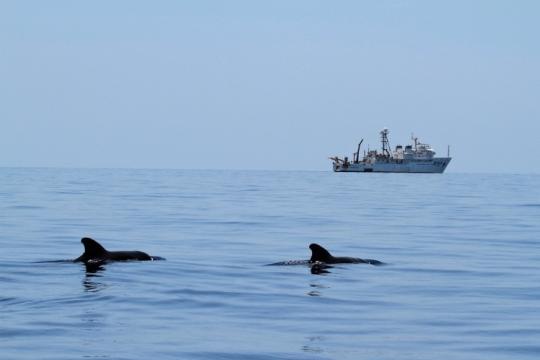 Pilot whales surface near the NOAA Ship Gordon Gunter. Credit: NOAA Fisheries/Melody Baran (Permit # 14450)
Pilot whales surface near the NOAA Ship Gordon Gunter. Credit: NOAA Fisheries/Melody Baran (Permit # 14450)
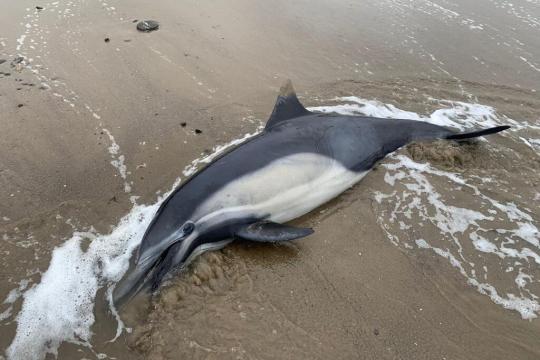 Deceased dolphin as a result of domoic acid poisoning. Credit: Channel Islands Marine & Wildlife Institute
Deceased dolphin as a result of domoic acid poisoning. Credit: Channel Islands Marine & Wildlife Institute
Toxic Algal Bloom Suspected in Dolphin and Sea Lion Deaths in Southern California
Management Overview
The short-finned pilot whale is protected throughout its range under the Marine Mammal Protection Act.
Additionally, the short-finned pilot whale is listed under:
- Appendix II of the Convention on International Trade in Endangered Species of Wild Fauna and Flora (CITES)
- Annex II of the Protocol for Specially Protected Areas and Wildlife (SPAW)

Conservation Efforts
Reducing Bycatch in Fishing Gear
Bycatch in fishing gear is a leading cause of short-finned pilot whale deaths and injuries in U.S. waters.
To reduce serious injuries and deaths of several marine mammal stocks incidental to the California thresher shark/swordfish drift gillnet fishery, NOAA Fisheries implemented the Pacific Offshore Cetacean Take Reduction Plan. Representatives from the fishing industry, regional fishery management councils, state and federal resource management agencies, the scientific community, and conservation organizations worked together to recommend mitigation measures to reduce entanglements. The plan includes gear modifications, such as net extenders and pingers, as well as skipper education workshops.
To reduce deaths and serious injuries of long-finned pilot whales incidental to the Atlantic pelagic longline fishery, NOAA Fisheries implemented the Atlantic Pelagic Longline Take Reduction Plan. Representatives from the fishing industry, regional fishery management councils, state and federal resource management agencies, the scientific community, and conservation organizations worked together to recommend mitigation measures to reduce bycatch of short-finned pilot whales. The plan includes a special research area, gear modifications, outreach material, observer coverage, and captains’ communications.
Reducing Vessel Strikes
Collisions between whales and vessels can injure or kill whales and damage vessels, but they often go unnoticed and unreported. The most effective way to reduce collision risk is to keep whales and vessels apart. If this is not possible, second best is for vessels to slow down and keep a lookout.
Learn more about reducing vessel strikes
Addressing Ocean Noise
Underwater noise threatens whale populations, interrupting their normal behavior and driving them away from areas important to their survival. Increasing evidence suggests that exposure to intense underwater sound in some settings may cause some whales to strand and ultimately die. NOAA Fisheries is investigating all aspects of acoustic communication and hearing in marine animals, as well as the effects of sound on whale behavior and hearing. In 2016, we issued marine mammal acoustic technical guidance for assessing the effects of anthropogenic (human-caused) sound on marine mammal hearing.
Overseeing Marine Mammal Health and Stranding Response
We work with volunteer networks in all coastal states to respond to marine mammal strandings including all whales. When stranded animals are found alive, NOAA Fisheries and our partners assess the animal’s health and determine the best course of action. When stranded animals are found dead, our scientists work to understand and investigate the cause of death. Although the cause often remains unknown, scientists can sometimes attribute strandings to disease, harmful algal blooms, vessel strikes, fishing gear entanglements, pollution exposure, and underwater noise. Some strandings can serve as indicators of ocean health, giving insight into larger environmental issues that may also have implications for human health and welfare.
Learn more about the Marine Mammal Health and Stranding Response Program
Marine Mammal Unusual Mortality Events
Short-finned pilot whales have been part of a declared unusual mortality event in the past. Under the Marine Mammal Protection Act, an unusual mortality event is defined as "a stranding that is unexpected; involves a significant die-off of any marine mammal population; and demands immediate response." To understand the health of marine mammal populations, scientists study unusual mortality events.
Get information on active and past UMEs
Get an overview of marine mammal UMEs
Educating the Public
NOAA Fisheries aims to increase public awareness and support for pilot whale conservation through education, outreach, and public participation. We regularly share information with the public about the status of pilot whales, as well as our research and efforts to promote their recovery.

Regulatory History
In 1997, NOAA Fisheries implemented the Pacific Offshore Cetacean Take Reduction Plan, which requires the use of pingers and 6-fathom net extenders in the California/Oregon drift gillnet fishery to reduce bycatch of cetaceans, including short-finned pilot whales. The Pacific Offshore Cetacean Take Reduction Team continues to meet and recommend measures to further reduce bycatch and achieve MMPA goals.
In 2009, NOAA Fisheries implemented the Pelagic Longline Take Reduction Plan, which includes a mainline length requirement as well as research and observer coverage recommendations. The Atlantic Pelagic Longline Take Reduction Team continues to meet and develop recommendations for further reducing bycatch of pilot whales and achieving MMPA goals.
Key Actions and Documents
Last updated by NOAA Fisheries on 04/24/2025
Science Overview
NOAA Fisheries conducts various research activities on the biology, behavior, and ecology of the pilot whale. The results of this research are used to learn more about this species.

Stock Assessments
Determining the number of pilot whales in each population—and whether a stock is increasing or decreasing over time—helps resource managers assess the success of enacted conservation measures. Our scientists collect information and present these data in annual stock assessment reports.
Acoustic Science
Acoustic research at NOAA uses underwater microphones to record sounds made by whales and dolphins. Once the recorders are collected and brought back to the lab, those sounds are detected on the recordings, and classified to species when possible. Using this data, scientists are able to learn more about the distribution and abundance of a species than using visual observations alone.
NOAA scientists have used recordings of short-finned pilot whales to describe their acoustic behavior and improve our descriptions of their stock structure in the Pacific Ocean. Similar experiments track the response of short-finned pilot whales to human-generated sounds by playing recordings of those sounds and observing the response of animals in the wild.
Eventually, what we learn about the way different species vocalize can be used to detect and count cetaceans using autonomous gliders and passive acoustic arrays.
Learn more about acoustic science
Molecular Genetic Research
Molecular genetic techniques are invaluable tool in cetacean research. Cetaceans are elusive, spending little time at the surface, and often live in remote areas that are difficult to sample. Because of this, classifying species and population structure using traditional morphological methods often gives us an incomplete picture of cetacean diversity. Analyses of molecular genetic markers provide insight about species’ population structure and diversity, and can reveal cryptic populations or subspecies that may be separated by oceanographic features, ecological differences, or social structure.
NOAA Fisheries has been using mitochondrial DNA control region sequences to examine population structure of short-finned pilot whales in the Pacific Ocean. Using these sequences, we have described the distribution of two types of short-finned pilot whale in the Pacific Ocean – one in the eastern Pacific Ocean, and the other in Hawai‘i and the western Pacific Ocean. In Hawai‘i, we’ve identified a resident population around the main Hawaiian Islands that is likely reproductively isolated from individuals in the Northwestern Hawaiian Islands and open ocean surrounding the islands.
More Information
Recent Science Blogs
Last updated by NOAA Fisheries on 04/24/2025
Research
2024 Northeast Spring Ecosystem Monitoring Cruise Completed
Sampling was expanded off the Mid-Atlantic to capture more plankton for studying ocean acidification.
Population Consequences of the Deepwater Horizon Oil Spill on Pelagic Cetaceans
We quantified population consequences for pelagic cetaceans, including sperm whales, beaked whales,…
Passive Acoustic Research at the Southeast Fisheries Science Center
The Passive Acoustic Ecology Program conducts research projects that use passive acoustics to assess populations and improve our understanding of cetaceans in the Gulf of America (formerly Gulf of Mexico) and U.S. waters of the Western Atlantic.
Passive Acoustic Technologies Used at the Southeast Fisheries Science Center
Researchers use advanced technology to record and study the sounds produced by marine mammals and human-made sources.
Last updated by NOAA Fisheries on 04/24/2025
